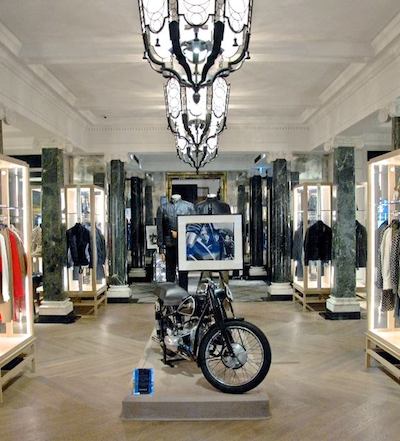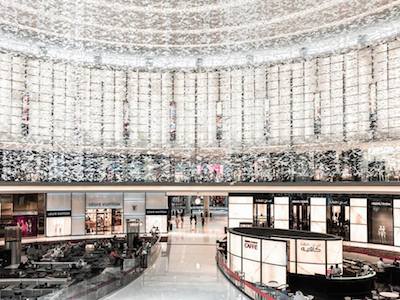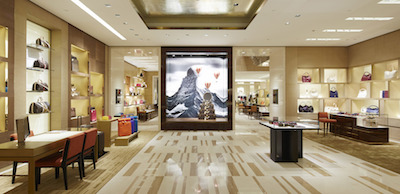 Photo of VivaLuxury courtesy of Bergdorf Goodman
Photo of VivaLuxury courtesy of Bergdorf Goodman
Dubai, United Arab Emirates may be trailing key luxury retail destinations such as New York and London today, but the market is projected to experience the fastest growth in sales over the next five years, according to a new report from Savills. The Middle Eastern city currently welcomes around 14.3 million overnight visitors each year, with the number expected to rise 9.7 percent by 2020. While still catching up to more established luxury shopping hubs including London's Regent Street and New York's Fifth Avenue, Dubai and the Dubai Mall in particular are seeing developments that may help it rise in popularity among retailers.
"Central London’s perception ranking was largely let down by the quality of its public realm features in relation to facilities and amenities, and it was on these features where New York and Dubai excelled," said Marie Hickey, director of retail research at Savills.
"Dubai’s retail landscape is dominated by shopping centers where public realm features have been designed in from day one," she said. "In the case of New York the perception regarding the quality of the public realm, for example 94.7 percent of respondents rated pavement quality as good to very good.
"Ultimately its been about investment in the physical retail environment that has helped to drive the perception scores of Dubai and New York. But, with a number of public realm initiatives in the pipeline for London’s West End we expect it will catch up with Dubai and New York over the next few years."
The Global Retail Destination Index 2016 from Savills, conducted in partnership with The Retail Group, benchmarks markets that attract international travelers. The report looks at similar prime shopping streets in each global city to create a like comparison, giving retailers a “physical” score based on data and a “perception” score based on a survey of 1,500 retailers. Measuring up New York is the top ranking retail city for both its physical characteristics and its perceived desirability. The city’s number one position can be attributed to its sales volume, with Oxford Economics measuring its total expenditures at $258.3 billion. New Yorkers spend an average of $8,500 per capita, and the U.S. city’s luxury spend was estimated to be the highest by Bain and Altagamma, at $24.9 billion in 2014. Based on quantitative features, such as tourist traffic, sales, property costs and retail mix, London comes out on top of the rankings. However, when more qualitative aspects of the cities were measured, London’s West End was fifth overall, falling behind top ranked New York and Dubai. However, 96 percent of London’s West End survey respondents would recommend the neighborhood, which includes Bond Street, Regent Street and Oxford Street, as a place to trade. Thirteen international brands are planning to open their first store location in London this year. Belstaff's New Bond Street Store
While London may fall behind New York in spending, its retail sales are expected to grow at a more rapid pace. London retail’s compound annual growth rate through 2020 is projected to be 2.9 percent, compared to New York’s 2.7 percent growth. This retail sales growth will be further driven by an expanding population and general economic growth tied to its attraction for international employers.
Dubai comes in second for perception score, but its physical offerings put it in fourth. Unlike a number of the other cities, where luxury retail is centered on high streets, Dubai Mall is the key shopping destination.
Dubai Mall’s Star/Grand Atrium Strip serves as the main tourist attraction, much like Paris’ Boulevard Hausmann. Its Fashion Catwalk is the prime real estate for flagships, while Fashion Ave is the prime spot for luxury.
The Dubai Mall’s facilities and amenities were ranked the best out of those studied, rating higher than shopping stretches including London’s Regent Street and New York’s Fifth Avenue. The report points out that shopping centers have more control over their infrastructure, whereas city sidewalk quality can be a problem and outside of the purview of the retailers.
Belstaff's New Bond Street Store
While London may fall behind New York in spending, its retail sales are expected to grow at a more rapid pace. London retail’s compound annual growth rate through 2020 is projected to be 2.9 percent, compared to New York’s 2.7 percent growth. This retail sales growth will be further driven by an expanding population and general economic growth tied to its attraction for international employers.
Dubai comes in second for perception score, but its physical offerings put it in fourth. Unlike a number of the other cities, where luxury retail is centered on high streets, Dubai Mall is the key shopping destination.
Dubai Mall’s Star/Grand Atrium Strip serves as the main tourist attraction, much like Paris’ Boulevard Hausmann. Its Fashion Catwalk is the prime real estate for flagships, while Fashion Ave is the prime spot for luxury.
The Dubai Mall’s facilities and amenities were ranked the best out of those studied, rating higher than shopping stretches including London’s Regent Street and New York’s Fifth Avenue. The report points out that shopping centers have more control over their infrastructure, whereas city sidewalk quality can be a problem and outside of the purview of the retailers.
 Dubai Mall
Another attractive quality of the shopping center is its affordability, with rent per square foot the lowest of any of the index city areas studied. For Dubai Mall space, renters pay an average of $240, compared to $3,500 on New York’s Fifth Avenue, the most expensive of the indexed shopping stretches.
New York is home to the most expensive retail real estate in the world, according to a new report by Cushman & Wakefield.
At $3,500 per square foot per year, Fifth Avenue from 49th Street to 60th Street, home to Saks Fifth Avenue, Louis Vuitton, Chanel and countless other luxury brands, is more than 50 percent pricier than the high street shops of Hong Kong’s Causeway Bay, which placed second. Real estate rates have risen amidst general economic uncertainty, but they are just one piece of the larger macroeconomic puzzle (see story).
London may be the most bang for retailer’s budgets, as the Savills report finds the West End delivers the most sales per operational cost of any of the seven cities studied, with $87.8 million per square foot. Singapore comes in second, followed by New York.
Bond Street scored the highest out of any luxury shopping avenue for its retail offer, which was based on the ratio of retail to other occupants and brand variety. The street has 96.5 percent of its ground floor occupied by retailers, compared to 82.1 percent on Avenue Montaigne.
Savills also looked at what brands are retailing, and found that Bond Street is home to all of the top 10 luxury brands indicated in Millward Brown’s 2015 Brandz List. Shoppes @ Marina Sands Singapore is the only other luxury street to gather the entire collection.
Dubai Mall
Another attractive quality of the shopping center is its affordability, with rent per square foot the lowest of any of the index city areas studied. For Dubai Mall space, renters pay an average of $240, compared to $3,500 on New York’s Fifth Avenue, the most expensive of the indexed shopping stretches.
New York is home to the most expensive retail real estate in the world, according to a new report by Cushman & Wakefield.
At $3,500 per square foot per year, Fifth Avenue from 49th Street to 60th Street, home to Saks Fifth Avenue, Louis Vuitton, Chanel and countless other luxury brands, is more than 50 percent pricier than the high street shops of Hong Kong’s Causeway Bay, which placed second. Real estate rates have risen amidst general economic uncertainty, but they are just one piece of the larger macroeconomic puzzle (see story).
London may be the most bang for retailer’s budgets, as the Savills report finds the West End delivers the most sales per operational cost of any of the seven cities studied, with $87.8 million per square foot. Singapore comes in second, followed by New York.
Bond Street scored the highest out of any luxury shopping avenue for its retail offer, which was based on the ratio of retail to other occupants and brand variety. The street has 96.5 percent of its ground floor occupied by retailers, compared to 82.1 percent on Avenue Montaigne.
Savills also looked at what brands are retailing, and found that Bond Street is home to all of the top 10 luxury brands indicated in Millward Brown’s 2015 Brandz List. Shoppes @ Marina Sands Singapore is the only other luxury street to gather the entire collection.
 Cartier store on Bond Street
London is home to more luxury retailers than any other European city, making the capital of the United Kingdom attractive for brands looking to cement a bricks-and-mortar presence in a strong market.
The “London Luxury Quarter — Global Destination Appeal” report, conceived by Heart of London Business Alliance and New West End Company and commissioned by JLL, appraises London’s prowess as a global destination with a flow of foreign visitors spending an estimate of $6.9 billion per year. While international markets are constantly evolving, London’s high streets have matured into a luxury destination offering affluent consumers a unique take on heritage, DNA and offerings (see story).
However, 94.7 percent of New York respondents agreed that the city has the best choice and quality of stores, placing it in first. Dubai and London follow.
Cartier store on Bond Street
London is home to more luxury retailers than any other European city, making the capital of the United Kingdom attractive for brands looking to cement a bricks-and-mortar presence in a strong market.
The “London Luxury Quarter — Global Destination Appeal” report, conceived by Heart of London Business Alliance and New West End Company and commissioned by JLL, appraises London’s prowess as a global destination with a flow of foreign visitors spending an estimate of $6.9 billion per year. While international markets are constantly evolving, London’s high streets have matured into a luxury destination offering affluent consumers a unique take on heritage, DNA and offerings (see story).
However, 94.7 percent of New York respondents agreed that the city has the best choice and quality of stores, placing it in first. Dubai and London follow.
"London, after New York, has the highest total retail sales of the seven cities examined and in terms of luxury spend is considered one of the top three global city markets," said Ms. Hickey. "This is driven by its global city status and its attraction to high-net-worth individuals.
"The volume and variety of international visitors London attracts is an added draw – London is the top city destination for international tourists in the world, meaning a store in London potentially widens the global reach of their brand," she said. "Ultimately, however it is this concentration of high spending consumers and London’s global reputation that continues to lure international luxury brands.
"London’s relative ‘affordability’, from a occupational cost perspective, is an added draw. The research found that total occupational costs on a per square foot basis in London’s premier luxury location are in the region of 45 percent cheaper than the equivalent location in New York. Yet considering the volume of luxury spend that takes place in New York its unsurprising it achieves some of the highest retail rents in the world."
Travel plans According to Mastercard’s Global Destination Cities Index from 2015, London saw the most tourists, with 18.8 million overnight visitors. These travelers spent a total $20.2 billion, with average total purchases of $1,075 while in the British city. Savills compared the number of international travelers coming through the top two airports in each city. While London comes out on top for number of travelers, Dubai saw the sharpest increase in visitors between 2014 and 2015, and the population of travelers entering Dubai is expected to grow 9.7 each year through 2020. Playing a major role in the attractiveness of a destination for internationals is the ease of the visa process. Britain allows residents of 90 countries to enter its border without a visa, placing it ahead of the United States, France and Italy in terms of openness to international visitors but behind Hong Kong and Singapore, which boast less restrictive policies. Louis Vuitton store in Shenyang, China
The UK China Visa Alliance is working to make it easier for Chinese travelers to visit the European country, successfully lobbying for a two-year visa for China residents. This would potentially get 265,000 more Chinese tourists to enter the UK each year.
Consumers’ shopping experiences also shape their desire to return to a particular destination. Based on qualities such as signage, ease of shopping, connectivity and service, Hong Kong comes out first, trailed closely by New York. Dubai ranks third, while London is in fourth place.
There are plans in the works to make London as even more attractive retail destination.
Louis Vuitton store in Shenyang, China
The UK China Visa Alliance is working to make it easier for Chinese travelers to visit the European country, successfully lobbying for a two-year visa for China residents. This would potentially get 265,000 more Chinese tourists to enter the UK each year.
Consumers’ shopping experiences also shape their desire to return to a particular destination. Based on qualities such as signage, ease of shopping, connectivity and service, Hong Kong comes out first, trailed closely by New York. Dubai ranks third, while London is in fourth place.
There are plans in the works to make London as even more attractive retail destination.
"London’s retail market remains one of the fastest moving and evolving in the world, with numerous new projects, stores and innovations underway at any one time," said Jace Tyrrell, chief executive at New West End Company.
"This has been a major factor in London’s competitiveness, and it will only get stronger - especially with Crossrail coming soon, public realm and placemaking strategies being implemented, new brands arriving each year and all supported by wide-ranging property-owner initiatives from New West End Company – to showcase these opportunities to the worldwide market."
